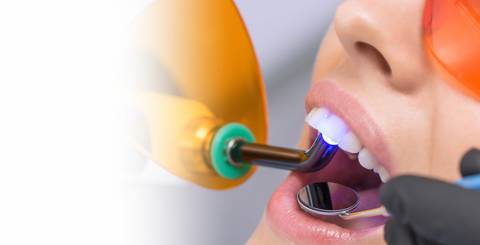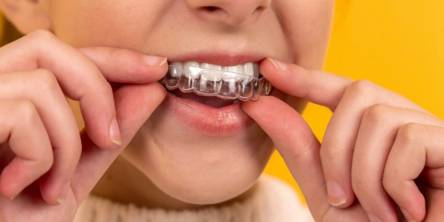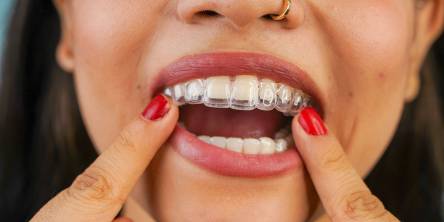Porcelain Veneers or Lumineers: What is the Difference, and Which is Best?

Whenever you see someone with an amazing smile then the chances are that they have at least some veneers. They may even have chosen to veneer all those beautifully perfect teeth that you can see whenever they grin. Dental veneers are a hugely versatile treatment and are frequently used in comprehensive smile makeovers or as the final step after completing orthodontic treatment. So, what are they and could they help you achieve the smile of your dreams?
Veneers are very thin shells made from porcelain that fit over the front surface of a tooth. Even though they are thin, they are strong and durable and are excellent for correcting many dental problems. Veneers could be a good solution if your teeth are only slightly out of alignment and you don’t really fancy orthodontics, if you have teeth that are stained, chipped or cracked, or.
You can also use veneers to close or minimize unsightly gaps in between teeth. When you have multiple veneers is even possible to lighten the overall shade of your teeth, or alternatively you may choose to have your teeth professionally whitened beforehand. That way your new veneers can be fabricated to match your sparkly new smile. So, what’s the difference between porcelain veneers and Lumineers? To explain this, it’s best to take a closer look at each type of veneer and especially the procedure to make and place these veneers.
Porcelain Veneers
With porcelain veneers, your cosmetic dentist will need to prepare your teeth before making and fitting your veneers. To do this, you will need a local anesthetic to ensure treatment is comfortable and pain free. Your dentist will carefully shape the front surface of each tooth to be veneered, removing approximately 0.5 mm of the tooth structure. This is approximately the same thickness as a dental veneer. It is essential to remove this material as otherwise your veneers could feel very bulky and the appearance wouldn’t be as natural as desired.
Once each tooth is prepared, your dentist takes a detailed dental impression to send to the dental lab. They will fabricate your veneers to your dentist’s exact design and prescription. At this point your teeth will need to be protected with temporary veneers. Otherwise they could feel too sensitive if left uncovered and they may look a little different because they have been specially shaped. Once your veneers are ready, you can return to your dental office to have them fitted and adjusted as necessary before they are permanently bonded to your teeth.
Lumineers
When you choose Lumineers then it usually isn’t necessary for your dentist to change the shape of your teeth. This is because Lumineers are amazingly thin, at approximately the same thickness as a contact lens and are around half the thickness of a conventional porcelain veneer. Instead of shaping your teeth, your dentist will merely need to take a dental impression to send to the dental lab and of course you will not need to wear temporary veneers. Once ready, you can return to the dental office where your new Lumineers will be fitted and adjusted before they are bonded to your teeth.
Advantages of Lumineers
The huge advantage of choosing Lumineers is that usually no tooth preparation is needed. Whenever possible this approach is always preferable because it conserves all your healthy tooth structure. They are amazingly thin so the results with this type of veneer are just as good as with conventional veneers. This form of treatment also means that you will not need any local anesthetic which can be preferable for people who really fear needles. Although Lumineers are ultra-thin, they can still mask badly discolored teeth and yet are translucent enough to accurately replicate natural tooth enamel.
Lumineers also tend to last longer than conventional veneers. Whereas conventional veneers will typically last for 10 years or more, Lumineers can last up to 20 years or even longer. What’s more, this treatment is reversible which isn’t the case with conventional veneers. When you have conventional veneers and your teeth are reshaped, then these teeth will always need to be protected in some form or another. Removing tooth enamel will increase the chance of these teeth becoming infected and decayed if they aren’t properly protected with veneers.
As no tooth preparation is generally needed for Lumineers, they can be removed if for some reason in the future you decide you prefer to go back to your natural smile, or if you need to have them removed for another reason.
Are Veneers or Lumineers Right for Everybody?
The idea of prep-free or prepless veneers like Lumineers is extremely appealing, but sometimes your cosmetic dentist might achieve better results when they can remove a tiny amount of tooth structure. By creating a little more space, they can design veneers that look very natural and beautiful. This might be the case if you have teeth that are a bit protrusive and where placing Lumineers would increase this protrusiveness, as even if it is only very slightly, it won’t be the look you desire.
Just like many dental treatments, veneers and Lumineers are an excellent choice for most people but they won’t be right for everybody. For example, if you have bruxism, a condition where you clench and grind your teeth then it’s not worth wasting your money on veneers until you have treated this problem. Clenching and grinding will damage your natural teeth and when you have veneers in place, it will most likely chip or crack them. It’s impossible to mend veneers or Lumineers, as instead they must be removed and replaced.
If you do have bruxism, then talk to your dentist about treating this problem before you have cosmetic dentistry. This will help to protect your natural teeth while ensuring that the outcome of your cosmetic dental treatment can be enjoyed for as long as possible.
The great thing about cosmetic dentistry is that there is almost always a good solution for every type of dental problem, using the most advanced cosmetic dental techniques and materials available today. After an initial consultation, your cosmetic dentist can advise you on the best techniques and treatments to create your dream smile, providing you with a plan that is fully customized to suit your dental needs and your dental health.
Similar Articles
A snow-white smile has been a symbol of health, self-confidence, and success. For this reason, teeth whitening is one of the most popular procedures in dentistry. But not everything is as simple as it might seem at first glance
In the age of social media, TikTok has quickly become a platform where trends are born and shared at lightning speed
A toothache can be unbearable and literally throw you out of your usual rhythm of life.
Cosmetic dental procedures improve the appearance of your teeth, but they also affect how your bite functions and how well you can maintain oral hygiene.
For many people, a visit to the orthodontist is solely associated with the fitting of braces in adolescence. But orthodontics is much more than just straightening teeth for aesthetic reasons.
Let’s face it: the moment someone says “Invisalign,” someone else whispers, “But don’t those turn your mouth into a high-tech vending machine?”
Most people know that brushing and flossing are important, but what often gets overlooked is just how much your overall health can benefit from regular dental checkups.
We have a certain expertise in several dental fields and dental implants are one of these. Dental implants are widely acknowledged as being the best replacement for missing teeth or failing teeth.
Maintaining your oral health is important not only for a bright, confident smile but also for your overall well-being.









